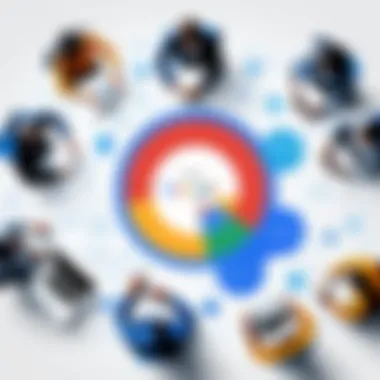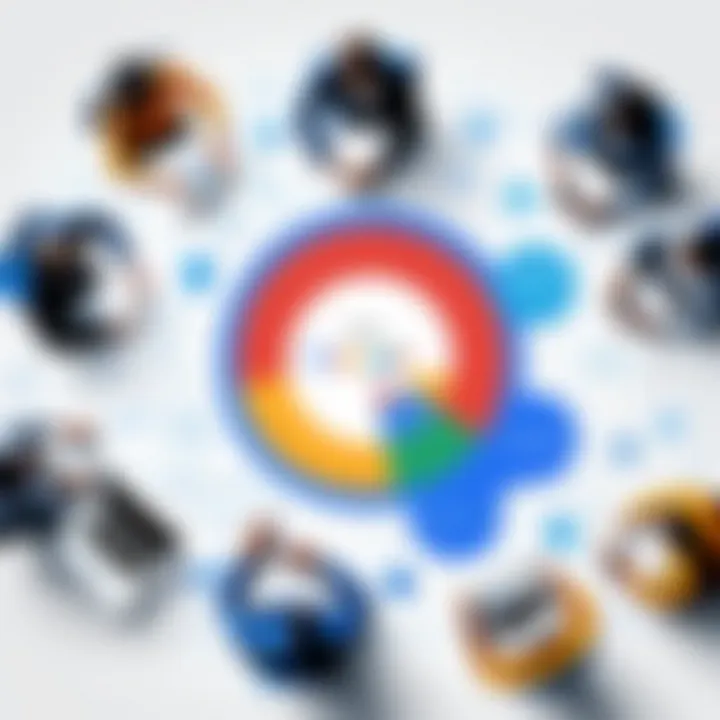Exploring the Role of a Google Product Owner


Intro
This article aims to dissect the multifaceted responsibilities of a Google Product Owner, providing insights into the unique skills required for success and the methodologies that underpin effective product management. By engaging with real-world examples and industry best practices, decision-makers, IT professionals, and entrepreneurs will gain depth in understanding this pivotal role.
Overview of Core Features
Description of Essential Functionalities
The Google Product Owner operates at the intersection of technology, business objectives, and user needs. To illustrate their essential functionalities:
- Vision and Strategy: Establishing a clear product vision that articulates outcomes based on user feedback and market research.
- Prioritization: Using frameworks like MoSCoW (Must have, Should have, Could have, and Won’t have) to determine what features are crucial for development cycles.
- Stakeholder Engagement: They act as the bridge between technical teams, marketing, sales, and customers, making sure that all voices are heard and integrated into the product lifecycle.
- Data-Driven Decision Making: Leveraging analytics and user feedback to drive iterations, ensuring that strategic product enhancements are validated through real data.
Comparison of Features Across Top Software Options
When reviewing the functionality of product management software widely used by Google Product Owners, several key elements stand out:
- Trello: Offers intuitive boards and card systems, making it simple for teams to visualize task progress.
- Jira: Known for its robust backlog management features tailored for Agile teams, ideal for technical environments.
- Asana: Focuses on ease of collaboration with tasks and subtasks that streamline project workflows for cross-functional teams.
These tools, while differing in approaches and UI, share core functionalities that support efficient product development.
User Experience and Interface
Insights into UI/UX Design Aspects
The Google Product Owner embodies a holistic understanding of how design impacts user interaction. UI/UX design is not just about aesthetics; it’s about creating an experience that resonates with users. This means:
- User-Centric Approach: Always putting user needs first during feature design and enhancements, employing methods like A/B testing and user personas.
- Interactive Prototyping: Utilizing tools like Figma or Adobe XD to create interactive mockups that allow for early feedback before full development.
- Feedback Loops: Establishing mechanisms for collecting user input post-launch to continuously refine and improve the product.
Importance of Usability and Accessibility
When it comes to product success, usability and accessibility act as twin pillars. A product that isn’t easy to navigate will drive users away, regardless of technical prowess. This reinforces the importance of considering diverse user populations:
- Accessibility Standards: Adhering to WCAG guidelines ensures that products remain usable for everyone, including those with disabilities.
- Inclusive Design Practices: Engaging with marginalized user groups during the design process to understand their needs creates a more universally accessible product.
Effective product ownership paves the way for innovation and can set a company apart in a crowded marketplace.
A Google Product Owner's role goes beyond mere management; it centers around empathy, vision, and strategic thinking. As the tech landscape continues to evolve, adapting to these roles with agility and foresight will be essential for future success.
Role Overview
The role of a Google Product Owner is pivotal in the landscape of tech-driven projects. It serves as the crucial link between development teams and stakeholders, necessitating a profound understanding of both the technical and business aspects of product management. In essence, a Product Owner ensures that the final product not only meets user needs but also aligns with organizational goals, thus playing a vital part in driving the overall success of a project.
Definition of a Google Product Owner
A Google Product Owner can be defined as the individual responsible for maximizing the value of the product resulting from the work of the Development Team. This role encompasses the management of the product backlog, making key decisions regarding feature prioritization, and ensuring clear communication among all parties involved. In other words, they are the visionaries who make sure the product development process runs smoothly and efficiently, steering it toward a successful outcome.
The Product Owner's job is multifaceted. They act not only as a leader but also as a facilitator, ensuring that requirements are met while simultaneously addressing concerns from various stakeholders. Whether it’s sifting through user feedback, shaping the product roadmap, or collaborating with engineers, they are the compass guiding the team through complex landscapes of project development.
Historical Context
The evolution of the role of Product Owner reflects the changing dynamics of technology and project management. Historically, product management was often a siloed function, leading to disjointed product development efforts. However, as the technology industry matured, particularly with the rise of Agile methodologies, the need for a more integrated role became apparent.
The Agile Manifesto, introduced in 2001, laid the groundwork for redefining product roles. It emphasized collaboration, flexibility, and customer-centricity, principles that are now at the very heart of the Google Product Owner’s responsibilities. Over time, companies recognized the necessity of having someone who could bridge the gap between developers, marketers, and customers.
As organizations began to scale their operations, the demand for skilled Product Owners surged. This shift highlighted the importance of this role within tech environments. Today, Google Product Owners are not only tasked with understanding user needs but also with leveraging data and analytics to continuously iteratively improve products. They embody the spirit of innovation and responsiveness that is crucial for success in a fast-paced digital landscape.
Core Responsibilities
The role of a Google Product Owner is pivotal in driving product success, enabling team cohesion, and ensuring that the product efficiently meets both market needs and business objectives. Within the tech landscape, these responsibilities are not merely tasks; they are fundamental elements that shape the trajectory of product development and innovation. Each core responsibility contributes to a holistic view of what it means to be an effective product owner, emphasizing the blend of strategic foresight and operational execution.
Managing Product Backlog
Managing a product backlog is akin to curating a detailed shopping list, except this list influences software capabilities instead of groceries. It involves the systematic organization of features, bug fixes, and technical improvements, ensuring everything is prioritized based on user needs and business goals. This backlog is not static; it evolves continuously based on user feedback, team capacity, and overall strategic direction.
An effective product backlog should prioritize tasks in a way that maximizes value delivery. This often means collaborating closely with cross-functional teams to keep the backlog healthy and aligned with user expectations. Tools such as JIRA or Trello can assist in managing this backlog, allowing for transparency and flexibility.
Prioritization of Features
Prioritizing features is like deciding what comes first in a race. The product owner must consider various factors such as market demand, user feedback, and technical feasibility when determining which features should leapfrog others in development. It’s about placing focus on those that provide the most significant impact to users and, ultimately, the business.


This prioritization is driven by frameworks like MoSCoW (Must have, Should have, Could have, and Won't have), which help in recognizing what is critical versus what can wait. Notably, engaging with stakeholders during this process aids in understanding their perspectives and fosters a sense of shared ownership.
Stakeholder Communication
Communication with stakeholders is the lifeblood of a product owner's role. Without clear dialogue, assumptions can cloud judgment and lead to misaligned goals. A product owner acts as the bridge between technical teams and business stakeholders, translating complex technical jargon into understandable terms and vice versa. It's about ensuring that everyone is on the same page regarding product vision and execution strategies.
Regular updates and transparent discussions mitigate risks of miscommunication. Tools like Slack for quick messaging or Confluence for documentation can enhance this communication flow. Building trust through reliable, open dialogue not only smooths the path ahead but also fosters a collaborative atmosphere conducive to innovation.
"Effective communication does not only build trust, it empowers the team to make informed decisions swiftly."
Essential Skills
In the rapidly evolving world of technology, the role of a Google Product Owner requires a distinct set of skills that allow them to navigate complexities and drive product success. These essential skills are not just buzzwords; they form the backbone of effective product ownership, enabling professionals to adapt and thrive in a competitive arena. Understanding these skills is crucial for anyone looking to make a mark in product management.
Technical Acumen
A Google Product Owner must possess a robust technical acumen. This doesn't mean they need to be expert developers, but they should understand the technical aspects of the product they oversee. Being conversant with software development processes, APIs, cloud technologies, and database management is invaluable. It aids in making informed decisions and facilitates communication with engineering teams. When technical challenges arise, having a grasp of the basics helps a Product Owner address problems efficiently and foster trust with their team.
"The ability to speak the language of technology is vital; it fosters collaboration and helps bridge the gap between technical and non-technical stakeholders."
Moreover, with the rise of technologies like AI and machine learning, a Product Owner should remain aware of innovations in the tech world. Following trends through channels like Wikipedia, Britannica, and relevant forums like Reddit can be beneficial.
Analytical Thinking
Analytical thinking stands out as another critical skill in the arsenal of a Google Product Owner. In practice, this involves dissecting complex data sets and drawing actionable insights from them. A savvy Product Owner should be comfortable working with performance metrics, user feedback, and market trends. The goal here is to translate raw data into clear strategies that enhance product offerings.
Skills in analytical thinking empower a Product Owner to:
- Evaluate user behavior and satisfaction.
- Identify patterns and potential areas of improvement.
- Support decision-making with evidence rather than intuition.
This skill is essential for prioritizing features and convincing stakeholders why certain paths should be pursued. Google from the outset has maintained a user-centric view that relies heavily on analytics, showing that good decisions stem from good data.
Interpersonal Skills
Finally, interpersonal skills can't be overlooked. Being technically savvy and analytical means little if a Product Owner can't communicate effectively. This role involves working with diverse stakeholders including developers, marketers, and designers. Establishing clear channels of communication ensures that visions and expectations are aligned.
Navigating the world of product ownership requires negotiation and conflict resolution. A good Product Owner actively listens, empathizes, and adapts their approach to meet the needs of their team and stakeholders. This cultivates a positive working environment, which can significantly impact productivity and creativity.
In summary, excelling in the position of a Google Product Owner is deeply tied to mastering essential skills in technical knowledge, analytical thinking, and interpersonal communications. These skills not only enhance individual efficacy but also propel the overall success of product development efforts.
Methodologies Employed
Understanding the methodologies employed in product ownership helps to highlight how a Google Product Owner navigates the complexities of software development. This section dives into frameworks and practices that facilitate efficient workflows, enhance team collaboration, and ensure that products meet user needs effectively.
Agile Framework
The Agile framework stands as a cornerstone for many tech teams, including those at Google. It's both a mindset and a methodology that fosters flexibility, collaboration, and rapid iteration. In this context, the framework allows Google Product Owners to adjust quickly to changes in market demand or user feedback, rather than sticking rigidly to a predetermined plan.
One key benefit of adopting Agile is its focus on delivering small, incremental updates. Instead of waiting for a large, fully-featured release, teams can roll out new features regularly. This not only keeps the product relevant but also builds a strong feedback loop with users who witness continuous evolution.
Moreover, Agile encourages regular introspection through iteration reviews and retrospectives, which helps identify what's working and what needs change. A core principle of Agile is that teams must respond to change rather than follow a strict plan. This requires a Product Owner to stay adaptable, ensuring that priorities align with both business objectives and user value.
Scrum Practices
Within the Agile framework, Scrum practices provide a structured approach to managing complex projects. Scrum breaks down the work into manageable chunks called sprints, typically lasting two to four weeks. Each sprint begins with a planning meeting where the team decides which features or bug fixes to tackle for that cycle. For a Google Product Owner, this means carefully selecting tasks from the backlog that align with strategic goals and user needs.
One of the standout features of Scrum is the daily stand-up meeting or Scrum meeting, where team members share updates and impediments. This fosters real-time communication and team synergy, allowing early detection of issues that might block progress. When the Product Owner is actively engaged in these scrums, they can help prioritize problem-solving efforts effectively.
In summary, employing Agile methodologies and Scrum practices allows Google Product Owners to navigate their roles adeptly, pushing teams towards success through iterative development and proactive stakeholder engagement. Embracing these methodologies reveals how product leaders can bring about fundamental changes in product delivery and customer satisfaction.
Collaboration with Teams
Collaboration serves as the backbone of a Google Product Owner's success. Working effectively across teams isn't just a component; it's crucial in driving the product vision forward. The dynamic nature of tech-driven environments requires a cohesive effort, with each team bringing unique perspectives and expertise to the table. This synergy can unearth insights that not only enhance product but also align strategies with business objectives.
The benefits of strong collaboration are multifaceted:
- Diverse Perspectives: Including input from various teams leads to a more rounded view of the product landscape. This can help prevent blind spots that might occur when working in silos.
- Enhanced Problem-Solving: Teams can cross-pollinate ideas. When challenges arise, pooling together their different skill sets often leads to more innovative solutions.
- Streamlined Communication: Regular interactions can facilitate smoother communication channels, minimizing misunderstandings and errors down the line.
Each collaboration facet is vital. In this article, we will look into specific team interactions:
Working with Engineering Teams


The relationship between Google Product Owners and engineering teams is almost like a marriage. It’s about mutual respect and understanding each side's needs. The Product Owner must articulate the product vision clearly while ensuring that engineers have a solid grasp of functionality requirements.
Daily stand-ups and sprint reviews are essential tools here. Using agile practices allows both parties to maintain alignment and ensure that development stays on track. For example, when a feature doesn't work as intended, engineering might need clarity on the Product Owner's expectations. Resolving such hiccups swiftly can drastically reduce cycles of frustration and inefficiency.
Interaction with Marketing
Marketing teams play a pivotal role in positioning the product in the market. A Google Product Owner must coordinate closely with marketing to understand target audiences and competitive landscapes. This interaction must be proactive rather than reactive.
A clear collaborative approach helps in crafting messaging that resonates with users. When a Product Owner engages marketers during the product development phases, it enables the creation of campaigns that highlight the product’s unique value proposition. For instance, during a launch, aligning the timing and strategy with marketing can boost initial user acquisition significantly.
"Good collaboration is like jazz: it requires the players to be somewhat in sync but also to improvise and adapt to each other."
Engagement with Design Teams
Design is not just about appearance; it encompasses functionality and user experience as well. A Google Product Owner must work hand-in-hand with design teams to ensure that the product meets user needs efficiently and intuitively. Their engagement can significantly affect the product’s success in the long run.
Using methods like design sprints fosters creativity and expedites problem-solving. Regular feedback loops are also important; they allow for adjustments based on user testing and stakeholder input. This iterative process creates a design that an enhances user satisfaction and drives engagement.
In essence, effective collaboration among the engineering, marketing, and design teams is not merely beneficial; it is essential for the Google Product Owner. These relationships ultimately dictate the success of the product and its acceptance in the ever-evolving tech market.
Impact on Product Development
The impact on product development is a crucial aspect of the Google Product Owner's role. Their influence is woven into the fabric of every product journey, from the initial spark of an idea to the final release and beyond. By effectively guiding development, the Google Product Owner plays a pivotal role in ensuring that products align with company objectives and meet user needs.
This section aims to explore specific elements, benefits, and considerations regarding the product owner's impact. It’s important to note that the role is more than just oversight of development tasks; it’s about acting as a bridge between various teams, all united by a common goal: achieving excellence in user experiences.
Influencing Product Vision
One of the most significant contributions of a Google Product Owner is shaping the product vision. This vision serves as a guiding star, influencing decisions throughout the development cycle.
- Collaboration with stakeholders: To effectively influence this vision, product owners must actively engage with a plethora of stakeholders including engineers, marketing teams, and designers. They gather insights and feedback, ensuring that the product addresses market needs while remaining feasible within technology constraints.
- Setting priorities: A well-defined vision allows product owners to prioritize features and functionalities. This strategic prioritization helps teams focus on what matters most, especially when deadlines loom. The clarity derived from a strong vision can significantly streamline collaboration and reduce friction in the development process.
- Aligning teams: The product owner's ability to communicate a clear vision fosters unity among diverse teams. By ensuring everyone is on the same page, they mitigate risks associated with misalignment and drift.
Driving User-Centric Design
Equally vital is the product owner's role in driving user-centric design. It’s not enough to just have a visually appealing product; it has to resonate with users’ needs and behaviors.
- User research and feedback: Google Product Owners must encourage robust user research activities. By engaging users through surveys, interviews, and usability testing, they can gather invaluable insights. This feedback loops back to inform design choices that elevate user satisfaction.
- Emphasizing usability: An emphasis on usability ensures that the product is not just functional but also enjoyable to use. Attention to detail in design decisions can make or break the user experience, impacting overall adoption rates.
- Adapting to changes: The tech landscape evolves rapidly, and a savvy Product Owner adapts the design based on changing user behaviors and expectations. They must remain agile, ready to pivot when user needs shift unexpectedly.
"A product that doesn’t resonate with its users is like a ship without a rudder. No direction, no success."
In summary, the Google Product Owner does not just steer the ship; they define its course and ensure it sails smoothly through the murky waters of product development. Their influence permeates across product vision and user-centric design, solidifying their position as a cornerstone of the development process.
Challenges Faced
In the dynamic realm of product ownership, especially at giants like Google, the role isn't just a walk in the park. There are hurdles that a Google Product Owner encounters regularly. This section takes a closer look at the core challenges, exploring their implications on both the product journey and the broader organizational landscape.
Managing Stakeholder Expectations
Getting everyone on the same page is no small feat. A key role of a Google Product Owner is to bridge the gap between various stakeholders. They have to juggle perspectives from developers, marketing teams, and upper management, all while ensuring that each party's needs are taken into account. It's like trying to tune a guitar with a variety of opinions on the right pitch.
Managing expectations involves clear and consistent communication. A Product Owner must set realistic timelines and deliverables, acknowledging the potential pitfalls before they emerge. If stakeholders believe that a product will launch at a certain date, but the development team faces unexpected issues, tensions can rise. It's crucial for the Product Owner to foster open discussions, offering updates while also managing feasible timelines without sugarcoating possible delays. It’s about finding that balance, negotiating between what’s technically feasible and what the stakeholders envision.
Balancing Business and User Needs
The tightrope walk of balancing business imperatives with user needs is another challenge that defines the role of a Google Product Owner. In today’s fast-paced tech world, the focus often tilts towards profitability and market trends. However, if a Product Owner neglects the wants and needs of the user base, the very foundation of the product can crumble.
Understanding user personas and conducting market research is vital here. While data-driven decisions often favor business growth, ignoring user feedback can lead to product failure. For instance, suppose the analytics show that a feature is underused, yet stakeholders demand its continuation due to perceived importance. In that case, the Product Owner must tactfully argue for a user-centered approach, demonstrating through metrics and real feedback how critical it is to pivot based on actual usage patterns.
In this context, a successful Product Owner incorporates user testing and feedback loops into the development process. This is where agility pays off. Adapting to user insights, iterating products based on feedback, and predicting shifts in user demands creates a more resilient product. Achieving this equilibrium is transitional; not a one-time fix but an ongoing strategy that needs constant attention and adjustment.
"A Google Product Owner must navigate through the complexities of stakeholder desires while staying rooted in user needs; the essence is to create a product that serves both worlds."
It is through these challenges that the Google Product Owner defines their value. By balancing varied interests and concentrating on user satisfaction, they not only drive successful project outcomes but also enhance the larger organization’s ethos of innovation and responsive development.
Future Trends in Product Ownership
The landscape of product ownership is evolving at an astonishing pace. As technology accelerates, it’s crucial to keep an eye on the emerging trends that will shape the functionality and influence of Google Product Owners. Knowing these trends not only assists these professionals in adapting but also ensures that products remain aligned with user needs and market demands. The trends highlighted in this article focus on emerging technologies and the adaptation to market changes, both critical to a Google Product Owner's toolkit.
Emerging Technologies
In today’s fast-changing tech environment, various emerging technologies are reshaping how products are conceived, developed, and deployed. Innovations like artificial intelligence, machine learning, and the Internet of Things are not just buzzwords; they are redefining the very fabric of product management.


For instance, artificial intelligence can automate mundane tasks, allowing Product Owners to focus on strategic decisions. Similarly, machine learning can enhance user experiences by predicting user behavior and tailoring features accordingly. Here are a few examples of how these technologies matter:
- AI-Driven Features: Product Owners can employ AI for analytics, offering deeper insights into user interactions, thus informing feature prioritization.
- Intelligent User Interfaces: With the rise of voice-assisted technologies, it’s vital for Product Owners to understand how to integrate these interfaces into their product roadmaps.
- Data-Driven Decisions: Utilizing big data tools, Product Owners can make informed decisions based on real-time analytics instead of relying on intuition alone.
As technology progresses, keeping abreast with these innovations allows Google Product Owners to be proactive rather than reactive, securing a competitive edge.
Adaptation to Market Changes
The market environment is akin to a choppy sea; it’s unpredictable, filled with waves of trends and changing consumer preferences. Google Product Owners must possess the agility to navigate through these waters effectively, adapting strategies and product features to align with market demands.
One pertinent factor is assessing user feedback. This isn't merely a checkbox on a project plan; it’s a substantial part of refining the product lifecycle. Understanding how to harness this feedback has never been more critical. Additionally, the rise of remote working calls for digital tools that facilitate effective communication and project management, enabling teams to adjust quickly to shifting priorities.
Consider the following:
- Continuous Learning: Regularly updating skill sets and knowledge about the industry, which can be accomplished through attending seminars, reading trade journals, and participating in relevant forums.
- Market Analysis Tools: Incorporating tools that analyze trends will give Product Owners insight into emerging consumer needs and competitive landscapes.
- Flexible Strategies: Emphasizing contingency planning for unexpected market shifts, allowing room for quick pivots in product direction.
"In a world of constant change, the only strategy that is guaranteed to fail is not taking risks." - Mark Zuckerberg
Thus, both technological advancement and market responsiveness are vital threads in the fabric of successful product ownership, ensuring that Google Product Owners remain at the forefront of innovation.
Career Path and Development
Navigating the world of a Google Product Owner involves understanding not just the present roles but also the pathways of career advancement and development. This section sheds light on the trajectory one might expect, as well as the strategies to enhance skills and qualifications vital for the role.
Necessary Qualifications
First and foremost, aspiring Google Product Owners need to acquire a certain set of qualifications that align with the demands of this dynamic role. Typically, a bachelor’s degree in fields such as business administration, computer science, or marketing lays a strong foundation. However, to truly shine in this position, one often finds that advanced certifications and specialized training can dramatically enhance prospects.
Some noteworthy qualifications include:
- Certified Scrum Product Owner (CSPO): This credential is essential for those who will adopt Agile methodologies in their work processes.
- Google Analytics Certification: Understanding user data through Google Analytics is crucial for making informed decisions about product directions.
- Product Management Certifications from reputable organizations like Pragmatic Institute: These credentials offer foundational knowledge to navigate the product lifecycle effectively.
Additionally, hands-on experience cannot be understated. Potential candidates often pursue internships or entry-level positions in product management, which provide valuable insights and practical skills in real-world environments. The key takeaway? Gaining qualifications that don’t just look good on paper, but also translate into effective product ownership skills in practice is imperative.
Building Expertise
Once the necessary qualifications are in hand, the more challenging and rewarding journey of building expertise commences. Unlike formal education, this part is often self-driven and requires a proactive approach to learning. Here, the focus should be on honing both hard and soft skills that directly relate to product ownership.
To build expertise, consider the following:
- Seek mentorship: Find seasoned product owners who can offer guidance and advice on navigating the complexities of the role. Learning from someone who’s walked that path can bring immense insight.
- Engage in project cycles: Get involved in different stages of product development—be it ideation, design, testing, or launch. Active participation helps understand the intricacies of each phase.
- Continuous learning: In a fast-paced tech environment, staying updated with trends and innovations is vital. Follow thought leaders, attend workshops, and engage in webinars to keep your knowledge sharp.
- Ask for feedback: Regularly seek constructive feedback from colleagues and stakeholders. This can help identify blind spots in your approach and foster improvement.
Ultimately, career advancement as a Google Product Owner is not just about gaining qualifications. It involves crafting a robust profile through diverse experiences, continuous learning, and networking. As someone climbs the ranks, the ability to adapt and evolve with market changes becomes essential not only for personal growth but also for contributing effectively to the teams and products they lead.
"Success in product ownership rarely comes from a single skill but is instead a tapestry woven from various threads of proficiency, experience, and adaptability."
By understanding the foundational requirements as well as engaging actively in professional development, anyone can step into the expansive role of a Google Product Owner with confidence.
The End
The conclusion of this article plays a vital role in synthesizing the extensive knowledge laid out throughout the preceding sections. It's more than just a summary; it encapsulates the essence of what a Google Product Owner represents in the fast-paced world of technology. Understanding this role leads to a greater appreciation of the strategic importance these individuals hold in guiding products from conception to successful launch and beyond.
In essence, the role of a Google Product Owner is multidimensional. They are not just a link between developers and stakeholders but are instrumental in shaping product vision and delivery. Their ability to manage competing demands while still keeping user needs front and center is what differentiates outstanding product ownership from mediocre efforts.
Key benefits of grasping this role include:
- Enhanced Collaboration: Knowing how a Product Owner interacts with various teams helps various departments coordinate better.
- Informed Decision-Making: Recognizing the key responsibilities facilitates better strategic planning within tech ventures.
- Future Readiness: It prepares organizations to adapt quickly to changes in the marketplace.
With the takeaway that effective product ownership can make or break a product's success, organizations should invest time into not only selecting the right person for this role but also nurturing their continuous development. Effective product owners cultivate a culture of innovation through analysis, proactive planning, and agility.
"Successful product owners morph as agents of change, ensuring not just survival, but thriving against the odds."
As we move into an era where technology continues to shape daily interactions, understanding the ins and outs of a Google Product Owner's role becomes not just useful but essential. It directly correlates to the success story of the products that impact our lives daily and the organizations that thrive on their excellence.
Summary of Key Points
In reviewing the journey undertaken in this article, several key points come to light:
- Role Complexity: The responsibilities of a Google Product Owner encompass several facets including managing backlogs and stakeholder communications.
- Skill Requirements: A range of skills from technical knowledge to interpersonal finesse is essential for effective performance.
- Methodologies: Proficiency in Agile and Scrum practices is crucial in navigating the modern product development landscape.
- Collaboration Dynamics: Interaction with engineering, design, and marketing teams is vital for eliciting a user-centric product approach.
- Long-Term Impact: Their influence extends beyond immediate releases, impacting product vision and user engagement strategies for the future.
Looking Ahead
With technology continuously evolving, the landscape for a Google Product Owner is bound to shift as well. Here are several projections worth considering:
- Emerging Skills: Familiarity with AI and machine learning will likely become a staple, as these technologies drive innovation across industries.
- Adaptability: The ability to pivot in light of market changes will be paramount for staying competitive. Product Owners who can anticipate shifts will be in high demand.
- Increased Presence of Data-Driven Decisions: As data analytics grows, Product Owners will need to integrate insights meaningfully into product tracking and strategy.
Ultimately, the future of product ownership seems not only promising but also complex. The role demands a balance of technical skill, strategic foresight, and a dedication to understanding user needs. By embracing continuous learning and adaptability, Google Product Owners can not only face the challenges ahead but also thrive in an increasingly intricate digital landscape.



